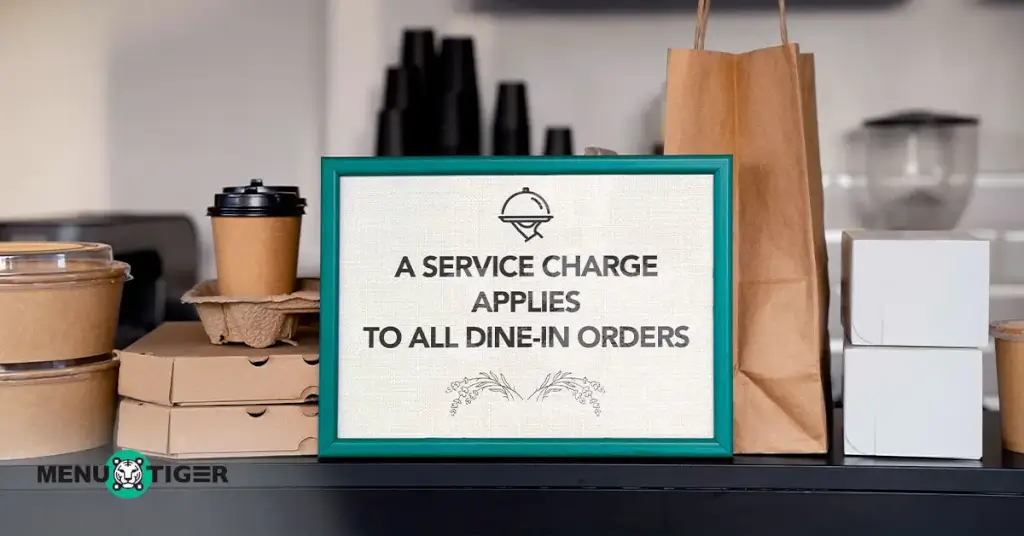
Service Charge vs. Tip: What’s the Difference?
Last Updated: January 8, 2026
While business owners understand the details of service charges vs. tips, many diners remain confused, often due to the gaps in communication and poor restaurant order management practices.
Daily Dot, a hometown newspaper of the internet, reported a TikTok clash between a bartender concerned over low tips and a customer frustrated by charges like service fees, taxes, and parking fees, adding confusion about how much to pay before even leaving a tip.
Situations like this raise the common question, “Isn’t tipping already a form of service charge?”
If you need a comprehensive comparison, this article will help you define the difference to ensure transparency, protect staff, and manage customer expectations effectively.
Is the service charge the same as a tip?
The answer is no. Service charges and tips are not the same. While both relate to payments for service, they differ in purpose, application, and legality. Here’s why:
Service charge
A service charge is an extra fee added to the price of a product or service to cover the cost of providing that service.
You can see service charges in places like restaurants, hotels, or banks. This fee is not optional; customers are required to pay it.
In restaurants, the most common types of service charges include:
- Delivery service charge – According to Upmenu, a restaurant management platform, third-party delivery platforms typically charge 15% to 30% per order, while in-house delivery fees usually range from $2 to $5.
- General service fee – Based on Homebased, cloud-based team and workforce management platform, A service charge is a set fee, usually between 3% and 20% of the total bill amount.
- Cancellation fee – There is no fixed standard for cancellation fees. However, under various State Consumer Protection Laws, businesses must provide clear refund and cancellation policies, including any reasonable and disclosed cancellation fees.
- Rush order or expedited service fee – The fee may vary, but the Federal Trade Commission Act (Section 5 – Deceptive Practices) and state laws require businesses to disclose these fees upfront and clearly explain their purpose.
- Gratuity or mandatory tip charge – Common rates, and according to Eat, a cloud‑based restaurant management platform, these charges typically range from 15% to 20%. Though no exact percentage is legally mandated.
Tip (Gratuity)
A tip (gratuity) is a voluntary payment given by a customer to a service worker as a reward for good service, on top of the base price of the service or product.
It is not required by law (unless stated as a “mandatory gratuity” on the bill), but is customary in many countries and industries, such as restaurants, hotels, delivery services, and more.
Restaurant service charge vs tip: what’s the difference?

As restaurant owners, it’s important to clarify the confusion between service charges vs. tips to ensure our guests understand before their next dining experience.
Here are the ten key differences between service charges definition vs. tips across various aspects:
1. Mandatory vs. voluntary charges
Service charge is mandatory. As restaurant operators, you can automatically add it to the bill, and customers are required to pay it. On the other hand, a tip is voluntary and is left at the customer’s discretion based on service satisfaction.
2. The rightful beneficiary
A service charge may be kept by the business or distributed to staff according to company policy. In contrast, a tip usually goes directly to the employee who provided the service unless tip pooling is in place.
3. Visibility on customer bills
A service charge appears as a separate line item on the bill. A tip, however, may not appear unless the customer chooses to add it.
4. Payroll handling
Since a service charge is classified as wages in the US and is taxable, the restaurant processes it as part of its revenue before being distributed to staff. In contrast, a tip goes directly to the employee and is reported separately for tax purposes.
5. Compliance with minimum wage laws
As the employer, you can use the service charge to help meet minimum wage requirements. A tip, depending on local laws, may also count toward minimum wage, but this depends on the country or state.
6. Employee rights
According to the Internal Revenue Service (IRS), service charges, like mandatory gratuities, are not considered tips but wages.
This means they belong to the employer first, who then decides how to distribute them. They are also subject to tax withholdings, such as income tax, social security, and Medicare.
Under the Fair Labor Standards Act (FLSA), 29 US Code section 203 (m), tips belong to employees, not the employer. Owners can't keep any portion unless it is part of a valid tip pool shared by tipped staff.
You can count tips toward the federal minimum wage only if you inform your employees of this arrangement and meet all FLSA requirements.
7. Automation possibilities
A service charge can be programmed into the restaurant’s point-of-sale (POS) system to apply automatically. A tip relies on the customer to enter the amount manually.
8. Consistency across shifts and staff
A service charge ensures more consistent earnings across all shifts and staff. A tip, on the other hand, can vary widely depending on customer generosity and service experience.
To manage this effectively, you need to understand restaurant employment statistics to fully execute fair turnovers
9. Reporting responsibility
Business owners are responsible for reporting and withholding taxes on service charges because they are classified as wages.
In tips, according to the IRS, employees who receive $20 or more in tips in a month are required to report the total amount to their employer in writing by the 10th day of the following month.
Those who earn less than $20 in tips during a month are not required to report them to the employer but must still declare the amount as income on their annual tax return using form 1040 by the IRS.
10. Flexibility in refund policies
Customers can remove, reduce, or increase a tip without restaurant approval. Service charges, once added, are not typically removed unless the restaurant makes an exception or in response to a customer complaint.

Legal and tax implications of service fee vs tips

Tipping isn’t universal and it often depends on local culture, labor laws, and taxes. For instance, restaurants use self-serve ordering systems to cut tipping, while others keep traditional full-service models where tipping is expected.
To better illustrate the differences in laws and tax regulations on tip vs. service charge between countries and states, consider the following examples:
France’s tipping rules
Under the 2021 Finance Law (Law No. 2021-1900, Article 5), tips in France, whether voluntary or mandatory, were exempt from both income tax and social security contributions for the years 2022 and 2023.
This aimed to support the heavily impacted hospitality sector after COVID-19.
Currently, as stated by Economie, an official economic and business portal, as per France’s consumer protection rules, if service is included, menus must show “prix service compris” (service included), and no extra service fee can be charged.
This makes restaurant menu pricing strategies essential for balancing profitability with customer expectations.
US taxable service charges and tips
The US, service charges distributed to employees are considered wages and are subject to taxation, as per Internal Revenue Service (IRS) Revenue Ruling 2012-18.
However, if the employer retains any portion of the charge, only the amount given to employees counts as their taxable wages.
In tipping, under federal law, restaurants can pay tipped workers as low as $2.13/hour, but their total pay (wage + tips) must reach at least $7.25/hour. If not, the employer covers the gap.
Note: State rules may differ. For example, service charge vs. tip in Florida follows federal tax laws but sets a higher tipped minimum wage than the federal rate.
Japan’s perspective on tipping
According to Nerdwallet, a US-based personal finance company and website, tipping is often seen as rude or unnecessary in Japan because of deeply rooted cultural and social values related to service and professionalism.
In Japanese culture, excellent service is expected as part of the job, not something that requires extra reward.
Service charges in Japan are legally treated as part of the sale or service, must be disclosed, and are subject to 10% consumption tax under the Consumption Tax Act and consumer-protection statutes.
How service charges affect restaurants

There are pros and cons of service fees at restaurants that can significantly influence various aspects of restaurant operations, from financial stability to customer perception and staff satisfaction.
1. Business cost
Fast Company, an American business magazine that covers innovation in technology, explains that service fees in restaurants help cover important business costs.
These costs include paying taxes for employees, providing staff benefits, processing credit card payments, and handling other daily expenses needed to run the restaurant.
Service fees also help with costs related to restaurant technology like maintaining POS systems, upgrading kitchen display screens, or subscribing to online ordering platforms.
2. Income for employees
Altametrics, a company that provides restaurant management solutions, points out that service charges can help ensure more stable employee pay.
These charges allow for fairer income distribution between front-of-house staff and back-of-house staff.
They also simplify payroll management for the restaurants because staff earnings become more predictable and less dependent on customer tips.
3. Customer perception
Studies from ScienceDirect and insights from The New Yorker suggest that replacing tips with mandatory service fees may lead to lower customer satisfaction.
This is because many American diners are sensitive to perceived price increases and unexpected or ‘gotcha' fees ratings.
4. Staff retention and morale
According to the National Restaurant Association (NRA), the restaurant industry experiences a high turnover rate, often between 75% and 100% annually for full-service establishments.
This frequent staff turnover can result in low employee morale, reduced productivity, and increased hiring and training costs, estimated to be around $3,000 to $5,000 per employee.
5. Operational efficiency
According to Altametrics, efficient payroll systems help improve a restaurant’s financial health by minimizing administrative workload, reducing payroll errors, and avoiding costly penalties related to labor law compliance.
That’s why it’s important to understand the restaurant gratuity guide to ensure fair and transparent tipping practices for staff and also to stay compliant with local labor laws.
How to implement a service charge in your restaurant

Here are clear, easy steps on how to implement a service charge system in your restaurant:
1. Set the service charge rate
Decide how much to charge. Most restaurants add a 3% to 10% service fee depending on location, service level, and business model.
2. Define where the charge applies
Clarify which transactions will include the service charge. Some restaurants apply it only to dine-in services, while others include it for takeout, delivery, catering, or private events.
Also, if you’re aiming for social media exposure, make this information visible online. The restaurant marketing statistics show that most customers browse a restaurant’s social media pages before deciding to visit.
3. Update menus and signage
Clearly state that a service charge will be applied on your menus, receipts, and order screens. This prevents surprises and builds trust with customers. If you are using a QR code menu, and other restaurant order systems for your establishment, just put up signage.
4. Use menu QR codes

Using a QR code menu system makes it easier for restaurants to adjust service charges and prices anytime without reprinting menus, so customers always see the latest information.
Menu QR codes also reduce the need for waitstaff to manually take orders, allowing guests to view the menu, place their orders, and even process payments independently.
This setup can help lower labor costs and offer faster, more convenient customer service.
5. Check legal compliance
The world always showcases diverse practices, including unique tipping cultures and strict regulations on tips vs. service charge.
Ensure that your service charge policy follows local labor and tax laws. Some regions have rules on how service charges must be taxed or distributed to staff.

The Rundown: Understanding restaurant fees and gratuities
Service charge vs. tip seems similar, but they serve different purposes in restaurant operations.
A service charge is a mandatory fee set and managed by the restaurant, often used to cover business costs or distributed among staff. In contrast, a tip is a voluntary reward left at the customer’s discretion, directly benefiting the service staff unless pooled.
For owners, service charges offer stable income distribution, easier payroll handling, and operational consistency.
For staff, tips provide immediate, performance-based rewards but with less predictability. Customers need clear, upfront communication to avoid confusion and ensure trust.
By understanding and applying these differences properly, restaurant owners can balance fairness, compliance, and guest satisfaction, creating a smoother experience for all.
FAQS
Eulla
Eulla joined MENU TIGER’s Content Team with a foundation in English teaching. She combines language expertise and creativity to produce engaging content that educates audiences and drives meaningful results.


